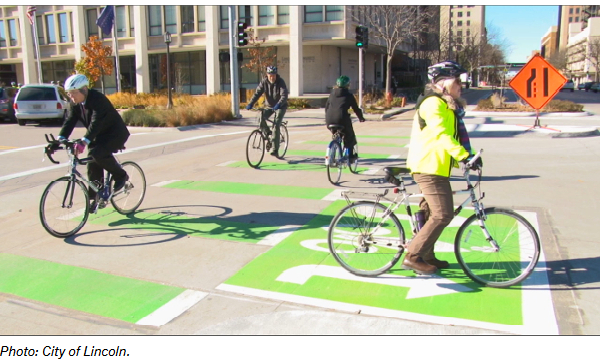The first official murmurings have taken place in Lincoln about the Safety Stop, aka, Stop-as-Yield, or, the Idaho Stop. If you are unfamiliar with these terms, the laws allow bike riders to yield and proceed when safe, rather than coming to a full stop. It’s a regulation that makes legal what many (most) cyclists do anyway. One study found that 1 in 50 cyclists came to a complete stop when no traffic was present. If there’s no cross traffic, the law treats a stop sign like a yield sign. A stop light is treated as a stop sign in half the states who have adopted the safety stop. Idaho was the first state to adopt this law 40 years ago. In Idaho, bicyclist injuries were dramatically reduced immediately after passage. In Delaware, who adopted the law in 2017, cyclist/car crashes at intersections went down 23% in the 30 months that followed. Streetsblog points out that it decriminalizes rational behavior. Coming to a complete stop on a bicycle is quite different than doing so with a car. “The laws allow bike riders to yield and proceed when safe, rather than coming to a full stop – and the key is “when safe.” None of these laws allow riders to blow through stop signs or demand the right of way.”

All this may seem counter-intuitive to non-cyclists. From behind a windshield, it may look like “entitled” behavior, or that we must feel we’re above the law. If you take into consideration that most collisions between bicycles and cars take place in intersections, the safety stop reduces cyclist time in the intersection. It improves cyclist visibility by putting cyclists out ahead of motorists where they can better be seen. It also makes intersections more efficient. Confusion about who goes next is resolved. Rational behavior is no longer relegated to “scofflaws”. The following from Building a Bicycle-Friendly Colorado sums this up in their safety stop fact sheet:
Scofflaw bicycling: Illegal but rational
○ Highlight: “The current iteration of our transportation system was not designed with
bicycles in mind, and most bicyclists seem focused on surviving in a system
designed for a very different mode of transportation.”
● Identifying behavioral norms among bicyclists in mixed-traffic conditions
○ Highlight: “Bicyclists must choose to break the law out of safety concerns or abide
by the law despite such concerns … when a bicyclist in the US behaves in ways
that may feel rational, safe, and/or efficient, they are frequently breaking the
law or behaving in a fashion that could be perceived as rude. This is largely
due to the fact that in the US, the laws regulating driving are often applied to
bicycling, despite the obvious differences in these two modes.”
Arkansas, Delaware, Idaho, North Dakota, Oklahoma, Oregon, Utah, Washington, and Colorado currently have the Safety Stop on the books. California passed it but the governor vetoed it against the preponderance of evidence showing it improves cyclist safety. They’re trying again.
